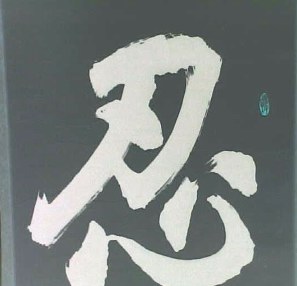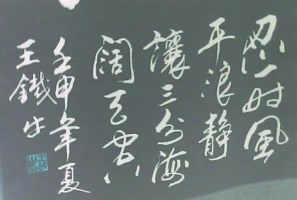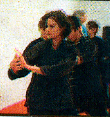Tai- Chi- Chuan | home
Background | Saddle back college Taichi DAY 2001 and photos | History of Tai Chi Chuan | LONG FORM MOVEMENTS | Shing I Chuan | Favorite Locations | Related Links | Contact Me
History of Tai Chi Chuan


Tai Chi The full name of this ancient Chinese martial art is Tai Chi Chuan "Tajiquan"
in Pinyin). In English, the correct pronunciation is usually "Tie" (as in
bow tie) "Chee" (as in cheetah) "Chwan" (with a long "a" sound, as in want).
It is most often translated as "Grand Ultimate System" or "Supreme Ultimate Fist.

Tai Chi Chuan is most often referred to as an internal martial art, indicating
that the emphasis is placed on strengthening the mind, circulating the Chi
or vitality, and relaxing the body so that it is free to move.
Beyond its martial applications, however, Tai Chi is also a complete system
of physics and philosophy, best characterized by the Tai Chi symbol known
as the Yin-Yang circle. In the Tai Chi symbol, two semicircles of
dark (Yin) and light (Yang) make a complete circle as they constantly merge
into each other, symbolizing the spirit of "moving harmony.
This harmony of motion succinctly describes the laws of Yin and Yang which
assert that in the phenomenal world (both physical and energetic) all existence
is a relationship between complimentary but opposing pairs. This can be observed
daily in the relationship between night / day, winter / summer, female / male, negative/positive,
and countless others. In this system, Yang represents all that is expressive,
productive and strength-oriented. Its opposite, Yin, is receptive, yielding
and internal. In the martial aspect of Tai Chi, the relationship between the
yielding force of Yin and the unbending force of Yang forms the core of the
fighting technique.
The yielding force is used to avoid or redirect an opponent's attack, while
the unbending force is used to counter attack. This change from yielding to
unbending is achieved in the form of a circle. Therefore, the main pattern
of Tai Chi Chuan is like many circles spiraling continually without end.
In application, these principles lead to a force which Tai Chi master Ching
Man Ching once described as "repelling 2,000 pounds with four ounces.
The History of Tai Chi Chuan The story and principles of Tai Chi Chuan have
been handed down through the past millennium both orally and through the traditional
writings of Tai Chi which are collectively referred to as the Classics. According
to legend, Tai Chi Chuan was created at the end of the Sung Dynasty by a Taoist
by the name of Chang Sen Feng.
A Shaolin disciple, Chang left the temple because he felt that the fighting
techniques developed there had become too harsh and brute strength oriented.
In order to find a suitable martial art for himself and other Taoist monks,
he journeyed to Wu Tang mountain and spent many years as a hermit, observing
the habits of long-lived animals such as turtles and cranes. Learning and
adapting these natural movements to the mechanics of the human body, and connecting
them with the guiding principles of Taoism.
Chang Sen Feng at last developed his Grand Ultimate
System. Eventually, Chang Sen Feng returned to the Shaolin temple where his
new internal art (often called Wu Tang Boxing) was taught to Chang Sun Chi.
At this point, the art consisted of only three techniques, with many fighting
applications, and was called Lao San Dao (Old Three Cuts).
Chang Sun Chi in turn taught Wang
Tsung Yueh, who changed the art by developing it into 13 postures. The modified
forms were taught to Jiang Fa, who later journeyed to the nearby Chen village
and taught Chen Wang Ting. Chen Wang Ting had been an army officer in Shan
Tung Province in 1618, and had become an accomplished martial artist. When
he returned to the Chen village in 1644, Chen took the Wu Tang internal boxing
methods learned from Jiang Fa and began to refine and perfect them.
He added postures from Sung Tai
Tzu Quan and various Shaolin forms, and combined all these with classic Chinese
internal health theories of passages of blood, air flow, and energy. His new
art became Chen Chia Quan, now called Chen Tai Chi Chuan. For generations,
the art of Chen Tai Chi was a secret heritage of just a small number of families.
Almost exclusively, parents passed
the knowledge on to their children. During the 1700's, Chen Wang Ting's style
had developed into the Five Routines of Pao Chuoi, a 32- and a 108-posture
Tai Chi form, and one Duan Da (short strike) form. By the end of the century,
the art had been passed to Chen Chang Shing who united and simplified the
various routines. Word began to spread about Chen Chang Shing's martial art,
and in the early 1800's, reached Yang Lu Tsan (1799-1872).
Yang Lu Tsan was a master of the
Hung Quan Shaolin style, and became fascinated with the stories of the new
internal art and it's health benefits. Eager to learn, Yang Lu Tsan travelled
to the Chen village to seek instruction from Chen Chang Shing. Officially,
no outsiders were allowed to learn Chen style Tai Chi Chuan, so Yang Lu Tsan
was forced to learn in secret. After mastering the art through 14 years of
training, Yang Lu Tsan moved to Peking, where he began teaching Tai Chi.
He noticed that the Chen style was
very difficult to learn for the average practitioner, so he modified it for
health purposes and ease of flow. His new system, formally called the Yang
style, has since become the most common of the Tai Chi styles in practice
today. One of Yang Lu Tsan's students was Wu Ching Chan (1831-1902). An accomplished
master of the Shuai Chiao style, Wu Ching Chan began to build on the foundation
of Chen Tai Chi, adding throwing and grappling techniques and attention to
protecting one's body, while retaining its soft, natural characteristics.
This resulting art became known
as Wu style Tai Chi. Wu Ching Chan passed his art on to his son, Wu Ching
To (1870-1972). In 1928, Wu Ching To moved to Shanghai. Two years later he
met Wei Hsiao Tang (1896-1982), third generation grand master of Ba Bu Tang
Lang (Eight Step Praying Mantis Kung Fu). Grand master Wei and Wu, both being
leaders of their arts, taught each other their respective styles completely,
holding nothing back.
Master Wei later moved to Taiwan,
where he passed his art on to his leading disciple Shyun Kwong Long (James
Sun), who is now the fourth generation grand master of Ba Bu Tang Lang. Master
Sun taught Wu style Tai Chi to a few select students, but taught openly, without
holding back any information. The Wu family, upon learning of this, did not
approve. Out of respect for the Wu family, master Sun stopped teaching Wu
style Tai Chi. However, realizing the tremendous health benefits of Tai Chi,
master Sun felt that he must spread Tai Chi to the masses.
Using his background as a medical
doctor, and his expertise in the martial arts, he set out to create a new
style of Tai Chi. After many years of research, reading the ancient manuscripts,
and analyzing many forms, he finally developed Shyun style Tai Chi. Shyun
style Tai Chi identifies itself in that it is very open, to allow for maximum
flow of Chi. Shyun style Tai Chi consists of three sets of forms: the high
set, the low set, and the fighting set. The high set is mainly used for relaxation
and general health. The low set emphasizes strength and conditioning. The
fighting set combines principles from the high and low sets to develop defense
skills. The high set is taught openly and without any restraints.